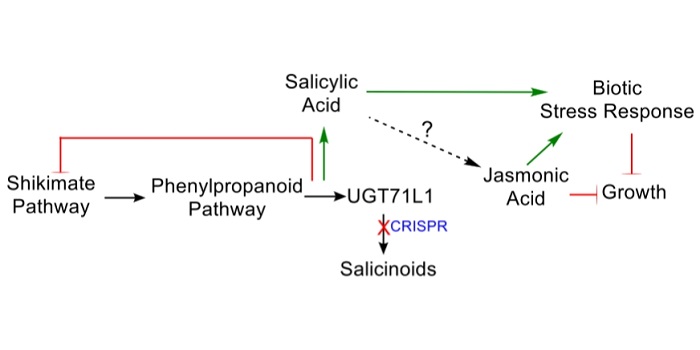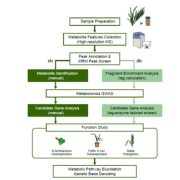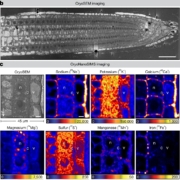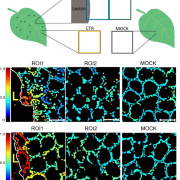UGT71L1 in Poplar Connects Salicinoid and Salicylic Acid Metabolism
Gordon et al. report that knock-out of a recently discovered enzyme for salicinoid biosynthesis in poplar leads to changes in salicylic acid and jasmonic acid metabolism and has unexpected effects on growth.. Plant Cell https://doi.org/10.1093/plcell/koac135
By Peter Constabel and Harley Gordon
Background: Poplars and willows make abundant anti-herbivore compounds called salicinoids, the original source of the widely used analgesic aspirin. Salicinoids are derived from a phenylpropanoid compound called cinnamic acid, but how the saliciniods are synthesized is still unknown. Previously, we reported that a glycosyl transferase enzyme called UGT71L1 is needed for salicinoid biosynthesis, but the other enzymes in the pathway are not known.
Question: Since UGT71L1 is necessary for the biosynthesis of the salicinoids, what happens if we disrupt this pathway by CRISPR/Cas9 in transgenic poplar plants? We hypothesized that in plants that lack the UGT71L1 enzyme and have disrupted salicinoid biosynthesis, we might be able to identify potential intermediates and other chemicals that would provide clues to help us elucidate the salicinoid pathway.
Findings: Transgenic poplars with CRISPR/Cas9 disruption of UGT71L1 accumulated only small amounts of salicinoids as predicted. These plants also showed unexpected growth abnormalities such as smaller serrated leaves, reduced internode length, and smaller stature. This was surprising, since salicinoids and other phenylpropanoid products are not known to affect plant growth. We therefore performed a rescue experiment and reinserted a functional UGT71L1 gene back into the knockouts. This corrected both the chemical and physical alterations, thus demonstrating directly that UGT71L1 disruption alone can cause developmental abnormalities. We then carried out metabolomic and transcriptomic analyses of the UGT71L1 knockouts. We discovered that the UGT71L1 knockouts have much higher levels of salicylic acid and jasmonic acid, well-known plant defense hormones. These hormones inhibit growth and could thus explain the physical phenotype. We hypothesized that extra salicylic acid comes from an unstable intermediate, and thus we proposed that salicyl salicylate is a UGT71L1 substrate and pathway intermediate. Next steps: Next steps are to validate salicylate glucoside as an intermediate and to determine how salicyl salicylate glucoside is processed to salicortin. We want to identify new enzymes that carry out the subsequent transformations, and ultimately to complete the biosynthetic pathway to the salicinoids.
Next steps: Next steps are to validate salicylate glucoside as an intermediate and to determine how salicyl salicylate glucoside is processed to salicortin. We want to identify new enzymes that carry out the subsequent transformations, and ultimately to complete the biosynthetic pathway to the salicinoids.
Harley Gordon, Christin Fellenberg, Nathalie D. Lackus, Finn Archinuk, Amanda Sproule, Yoko Nakamura, Tobias G. Köllner, Jonathan Gershenzon, David P. Overy and C. Peter Constabel. (2022). CRISPR/Cas9 Disruption of UGT71L1 in Poplar Connects Salicinoid and Salicylic Acid Metabolism and Alters Growth and Morphology.









